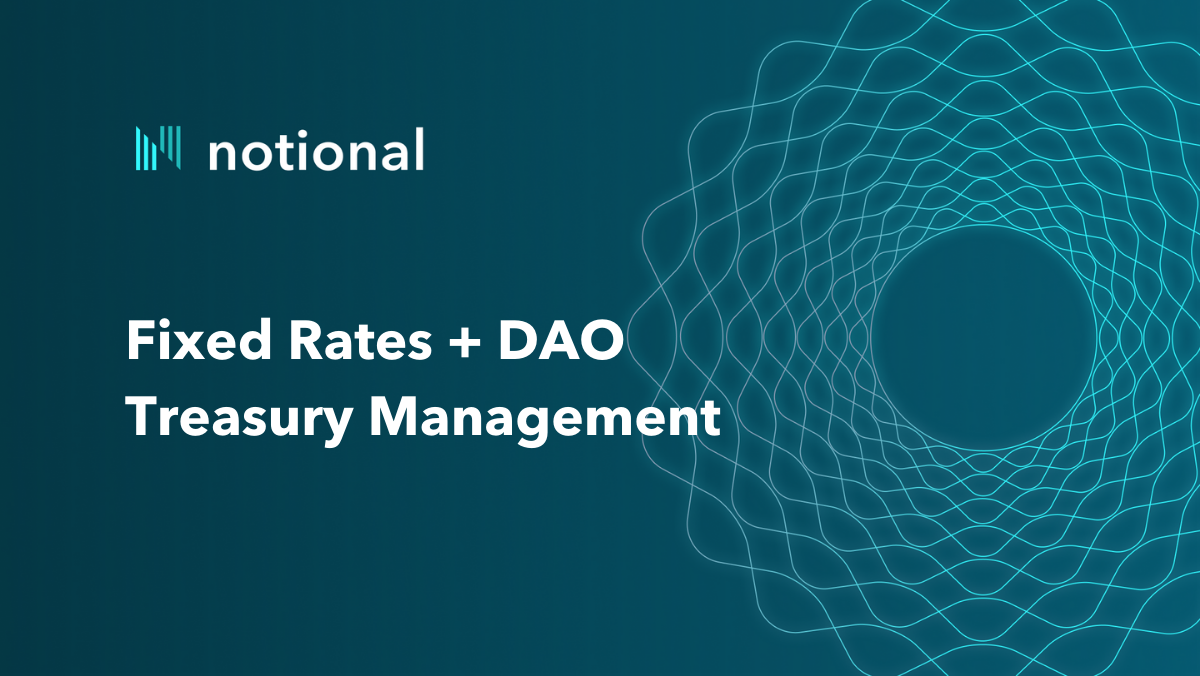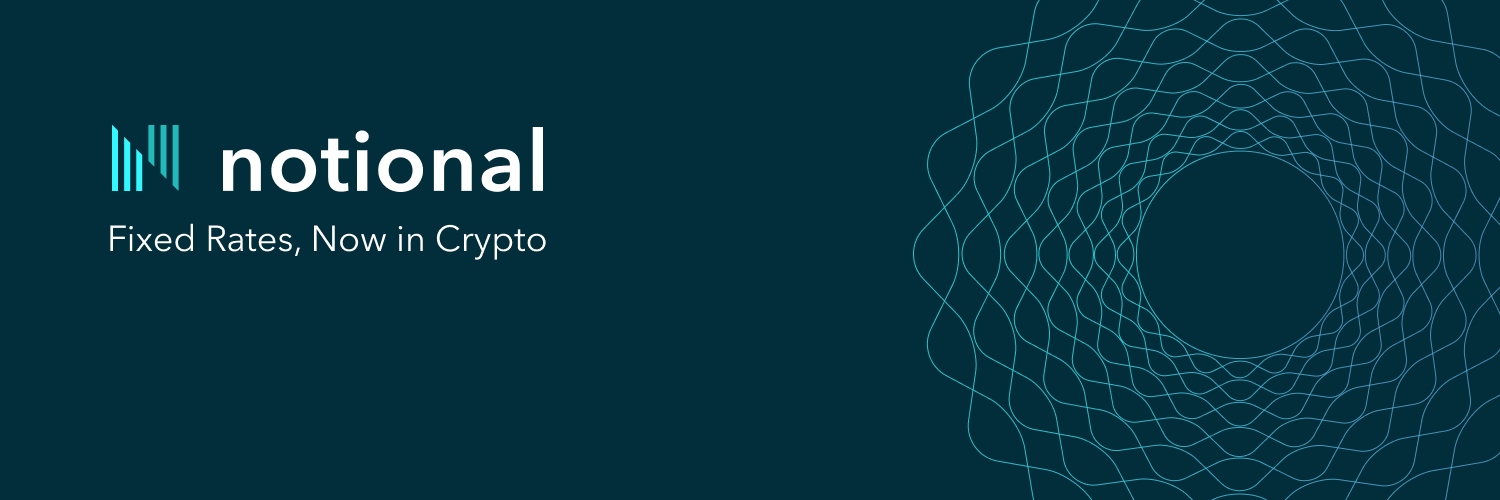
DAO Treasury Management using Notional Finance
With the rise of DeFi, multiple DAOs have built considerable treasuries, with more than a dozen DAOs holding over $100M in reserves. As a result, DAO treasury management is becoming an increasingly important topic amongst governance delegates.
With the rise of DeFi, multiple DAOs have built considerable treasuries, with more than a dozen DAOs holding over $100M in reserves. As a result, DAO treasury management is becoming an increasingly important topic amongst governance delegates.
Although each DAO is unique and has its own idiosyncrasies, we believe that most of them should think about allocating part of their treasuries to fixed income opportunities as a way to:
- Generate predictable returns over set periods of time;
- Turn their reserves into productive assets to generate new revenue streams;
- Have greater visibility over the DAO’s future cash inflows & outflows, enabling better planning.
We believe Notional is well-positioned to enable the use of fixed rate instruments for DAOs with:
- High fixed rates without token incentives (ex: 6.0% - 8.5% fixed rates on USDC & DAI for up to one year)
- Low slippage
- Low fees
- No credit risk
- Free redeemability
- Low smart-contract risk
It is also worth noting that some protocols have already started implementing fixed rates strategies on their reserves. For example, Pool Together community members assembled an improvement proposal to lend 500K USDC and 480K DAI from their v3 reserves to Notional in order to increase the yield obtained on treasury assets while keeping a low-risk profile.

The case for fixed-rate instruments in DAO treasury management
The top priority for DAOs is to ensure that they will have sufficient capital to fund their operations over long periods of time, irrespective of market conditions. Consequently, multiple DAOs have started allocating a part or even the entirety of their reserves to stablecoins as it allows for greater certainty, especially during market drawdowns.
Unfortunately, stablecoin reserves represent a significant opportunity cost for DAOs as they usually sit in non-productive assets. For some DAOs, this opportunity cost already represents millions of dollars a year and is rapidly compounding.
The allocation of a portion of a treasury’s assets into a set of conservative, fixed yield-generating strategies can not only decrease this opportunity cost by enhancing a DAO’s revenues but also allow for increased visibility and better planning. Fixed rates products uniquely enable DAOs to know the exact amount of yield they will be able to generate from investing part of their assets over a set period of time. Moreover, contrary to variable rates, fixed-rate products allow DAOs to make more informed investment decisions before deploying any capital.
Finally, short-term fixed-rates instruments are highly liquid, enabling DAOs to easily exit their position early at the prevailing market interest rate if they ever encounter an urgent liquidity need.
Developing a fixed rate allocation strategy
One key consideration when implementing a DAO treasury management strategy is establishing an appropriate allocation between stablecoin reserves, money-market instruments, and fixed rates.
As a guiding principle, we believe DAOs should keep their treasury in assets with liquidity profiles that match the DAO’s operational expenses patterns. For example, if a DAO has no visibility on its upcoming operational expenses, it should keep a higher percentage of its reserves in stablecoins or short-term fixed income instruments for increased flexibility. On the other hand, If a DAO has highly predictable expenses, it should take on more illiquidity risk by investing in longer-dated fixed-rates instruments.
In either case, a DAO should keep part of its treasury in cash in order to cover its short-term operational expenses (ex: keep one year of expenses in stablecoin reserves) and keep an additional buffer to account for any potential surprises. Once its short-term operations are covered, the DAO should invest the rest of its treasury in a set of fixed-rate opportunities if the expected returns are sufficient to make the operations worthwhile.
As an example, if a DAO holds $10M of USDC and knows that under conservative assumptions they will need $2M to finance their operations (ex: salaries of core contributors, grants and infrastructure expenses) over the next year and want to keep a $1M buffer, they could at a maximum invest $7M or 70% of their treasury in low duration fixed-income instruments.
Reasonably a DAO could decide to invest only 10% of its treasury in low duration instruments at first and increase its allocation over time as the visibility on its cash inflows and outflows increases. Over time a DAO could even invest in longer-dated maturities to match known obligations, similarly to how insurance companies or pension funds operate. For large treasuries, fixed income instruments could potentially create large enough inflows such that it covers a large part of a DAO’s operational expenses.
Considerations of fixed-rate instruments
When considering investing part of their treasury in fixed-rate instruments, DAOs should consider the following elements:
Absolute return of the strategy: Is the net amount that will be generated from the implementation of the strategy worthwhile, considering the additional risks?
Yield generation mechanism: Is the yield generation mechanism of the proposed fixed-rate instrument sustainable? In other words, does the yield depend on incentives or token prices?
Early withdrawals: Are there any lockups or early withdrawal fees?
Slippage: How much interest rate slippage will result from placing a large buy/sell order?

Fees: What are the applicable fees when entering/exiting the fixed-rate position (ex: gas fees, trading fees)?
Credit risk: Is the stated yield dependent on the creditworthiness of the borrowers?
Reinvestment risk: Will the yield-bearing instrument continue to earn yield after it has matured? Will it require the DAO to reinvest its position?
Smart contract risk: Is the protocol’s smart contract risk low and have they been audited?
The case for Notional’s fixed rates
Absolute returns: Notional’s USDC and DAI fixed rates products currently yield in the 6.0% - 8.5% range representing an attractive opportunity for DAOs to deploy part of their treasuries, especially when compared to the rates offered by other lending protocols.
Source: https://info.notional.finance/ as of 2022-02-28
Yield generation mechanism: Notional fCash yields do not rely on any incentives or any token prices. The rates received by lenders are paid by borrowers or what we call “organic yields”.
Early withdrawals: Borrowers & lenders can close their Notional positions before maturity at the prevailing market interest rate.
Slippage: Notional currently enables users to execute $1M stablecoin trades at 0.1% interest rate slippage and $5M trades with less than 1% interest rate slippage.
Fees: Fees on Notional are currently 0.3% on the annualized interest rate. This means that the transaction fee scales with time to maturity. If a user borrows for 1 year he will pay roughly 0.3% of his principal, while a 6 month borrower would only pay a 0.15% fee on his principal.
Credit risk: Notional is an over-collateralized protocol and is therefore not subject to credit risk. The Notional protocol is still subject to under-collateralization risks, although these risks are mitigated through Notional’s conservative governance parameters.
Reinvestment risk: Upon maturity, lending positions on Notional auto-convert to earning the variable interest rate. Thus if a DAO does not automatically reinvest its treasury allocation, it still earns the variable rate.
Smart contract risk: Notional is subject to smart contract risks. Multiple security audits and initiatives have been undertaken to mitigate these risks:
Notional’s smart contract risk can also be insured using Nexus Mutual or Risk harbor.
Case study
Pool Together community members have proposed to lend 500K USDC and 480K DAI from their v3 reserves to Notional to generate additional yield on their treasury reserves. By doing this the Pool Together treasury would be able to lock in 6.0 to 8.5% fixed rates which is considerably higher than what Aave is currently offering. It is worth noting that the Pool Together community conducted a risk assessment of Notional before putting this proposal out and reached the conclusion that Notional was a low counterparty and low smart-contract risk protocol.

Resources
About Notional Finance📈
Notional is the first decentralized, Ethereum-based protocol for borrowing and lending at fixed rates and fixed terms. With variable rate lending, DeFi can only serve a small segment of the crypto lending market because variable interest rates don’t provide the certainty that lenders and borrowers require. Notional fixes this by creating a true market for lenders and borrowers that empowers individual investors, business owners and institutional investors.
After raising a $10 million Series A in May 2021 from some of the top VC firms, including Coinbase Ventures, Notional’s protocol was relaunched on 11/1 with a host of new features as well as the NOTE governance token. Notional is now a top 10 DeFi lending protocol, with more than $450M in total value locked.
To find out more, follow Notional on Twitter @NotionalFinance, subscribe to the newsletter, join the Discord, or check out the website to learn more.

Notional Finance Newsletter
Join the newsletter to receive the latest updates in your inbox.







